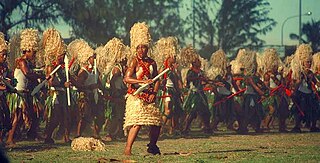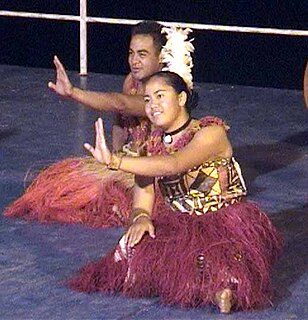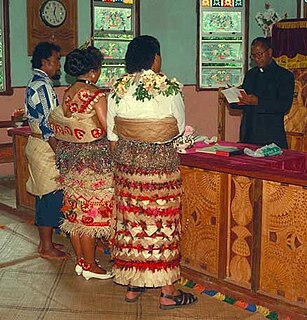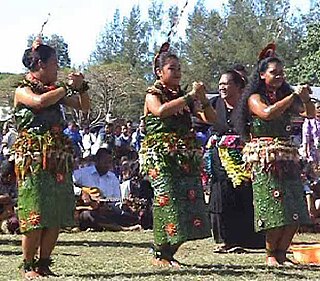 W
WThe Tongan archipelago has been inhabited for perhaps 3000 years, since settlement in late Lapita times. The culture of its inhabitants has surely changed greatly over this long time period. Before the arrival of European explorers in the late 17th and early 18th centuries, the Tongans were in frequent contact with their nearest Oceanic neighbors, Fiji and Samoa. In the 19th century, with the arrival of Western traders and missionaries, Tongan culture changed dramatically. Some old beliefs and habits were thrown away and others adopted. Some accommodations made in the 19th century and early 20th century are now being challenged by changing Western civilization. Hence Tongan culture is far from a unified or monolithic affair, and Tongans themselves may differ strongly as to what it is "Tongan" to do, or not do.
 W
WGarcinia sessilis, known as heilala in Tongan, is an evergreen tree native to the Pacific regions of Solomon Islands, Fiji, Samoa and Tonga. The heilala flower is the national flower of Tonga.
 W
WKalia is the Tongan adaptation of a drua or double-hulled Polynesian sailing watercraft.
 W
WKava or kava kava is a crop of the Pacific Islands. The name kava is from Tongan and Marquesan, meaning 'bitter'; other names for kava include ʻawa (Hawaiʻi), ʻava (Samoa), yaqona or yagona (Fiji), sakau (Pohnpei), seka (Kosrae), and malok or malogu. Kava is consumed for its sedating effects throughout the Pacific Ocean cultures of Polynesia, including Hawaii, Vanuatu, Melanesia, and some parts of Micronesia, such as Palau. To a lesser extent, it is consumed in nations where it is exported as a herbal medicine.
 W
WA kiekie is a Tongan dress, an ornamental girdle around the waist, mainly worn by women on semiformal occasions, but nowadays also sometimes by men. At highly formal occasions both gender will settle for a taʻovala. At casual occasions no girdle is needed for any gender, although women may continue wearing a kiekie even then, as it is considered an easy sitting, nice looking decoration, with which one can show off..
 W
WLaulau, otherwise known as Lū in Tonga, Palusami in Fiji and Samoa and Rukau in the Cook Islands, is a Polynesian dish consisting of cooked taro leaves containing fillings such as pork, fish or coconut cream. In old Hawaiʻi, laulau was assembled by taking a few leaves and placing a few pieces of fish and pork in the center. In modern times, the dish uses taro leaves, salted butterfish, and either pork, beef, or chicken and is usually steamed on the stove. Laulau is a typical plate lunch dish and is usually served with a side of rice and macaroni salad.
 W
WColocasia esculenta is a tropical plant grown primarily for its edible corms, a root vegetable most commonly known as taro, kalo, dasheen or godere. It is the most widely cultivated species of several plants in the family Araceae that are used as vegetables for their corms, leaves, and petioles. Taro corms are a food staple in African, Oceanic, and South Asian cultures, and taro is believed to have been one of the earliest cultivated plants.
 W
WColocasia esculenta is a tropical plant grown primarily for its edible corms, a root vegetable most commonly known as taro, kalo, dasheen or godere. It is the most widely cultivated species of several plants in the family Araceae that are used as vegetables for their corms, leaves, and petioles. Taro corms are a food staple in African, Oceanic, and South Asian cultures, and taro is believed to have been one of the earliest cultivated plants.
 W
WThe ʻotuhaka is a traditional Tongan group dance with prominent Sāmoan influence wherein the performers are seated and make gestures with their arms only, with some accentuation from head and body.
The beginnings of the postal history of Tonga can be traced to the Wesleyan missionaries, who landed in the islands in 1826, and sent regular communications back to London and Sydney from the day of their arrival. The Tongan Post Office was established in 1887, but even before then postage stamps featuring the image of King George Tupou I were produced in New Zealand.
 W
WA taʻovala is an article of Tongan dress, a mat wrapped around the waist, worn by men and women, at all formal occasions, much like the tie for men in the European and North American culture. The ta'ovala is also commonly seen among the Fijian Lau Islands, a region once heavily influenced by Tongan hegemony and cultural diffusion.
 W
WTapa cloth is a barkcloth made in the islands of the Pacific Ocean, primarily in Tonga, Samoa and Fiji, but as far afield as Niue, Cook Islands, Futuna, Solomon Islands, Java, New Zealand, Vanuatu, Papua New Guinea and Hawaii. In French Polynesia it has nearly disappeared, except for some villages in the Marquesas.
 W
WThe tauʻolunga is a traditional Tongan dance. The type of dance is comparable with (some) Hawaiʻian hula or the Tahitian ʻaparima.